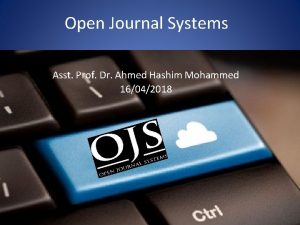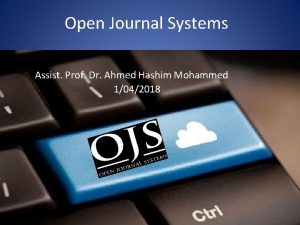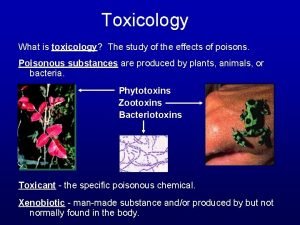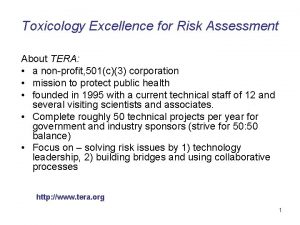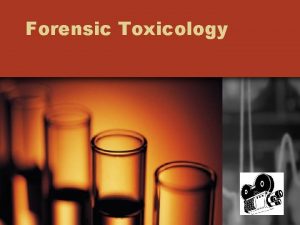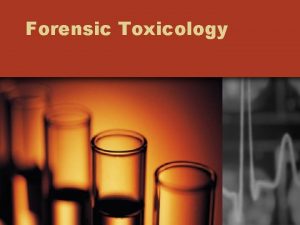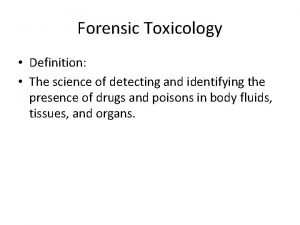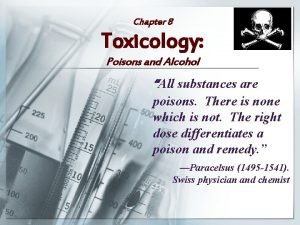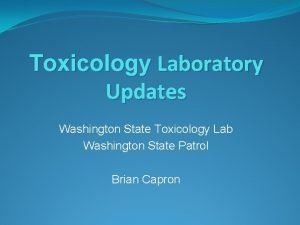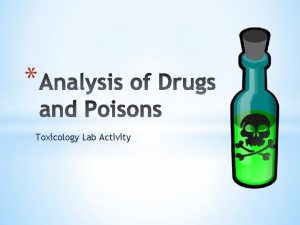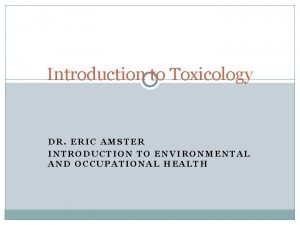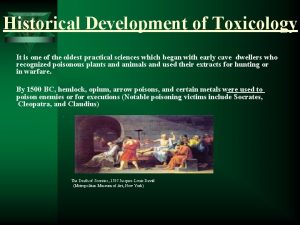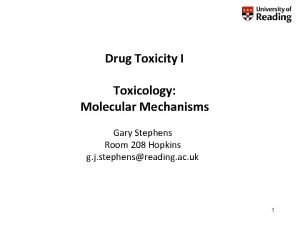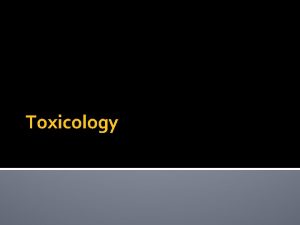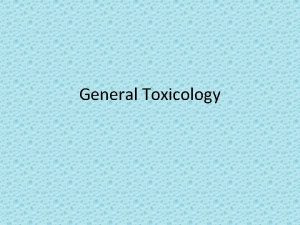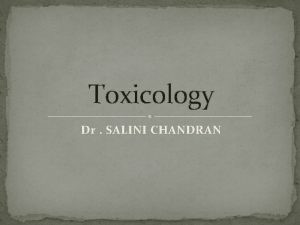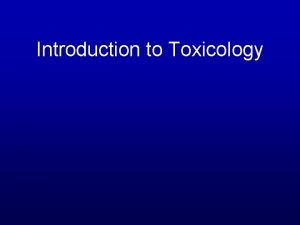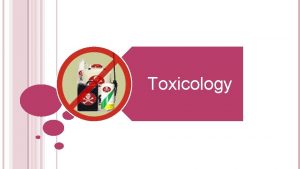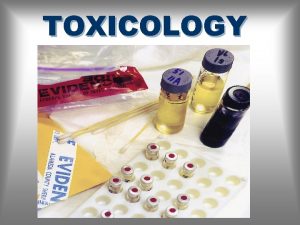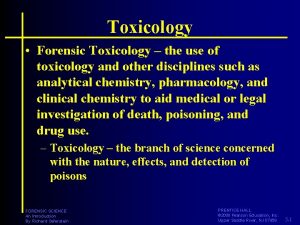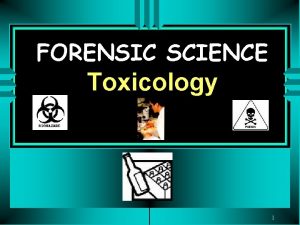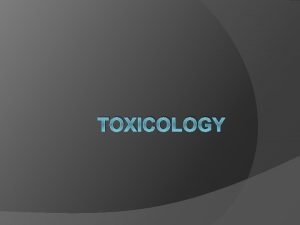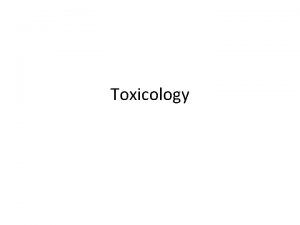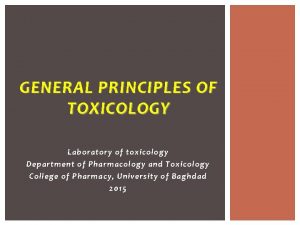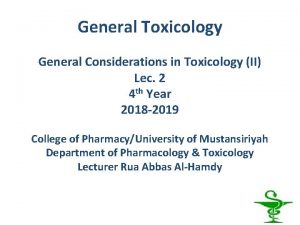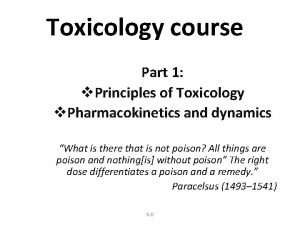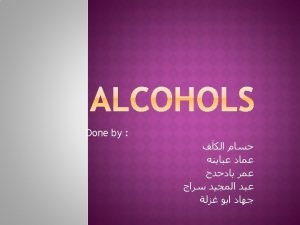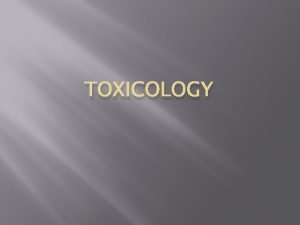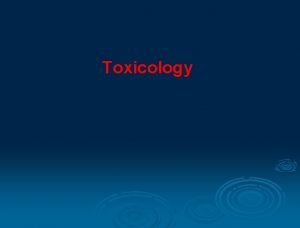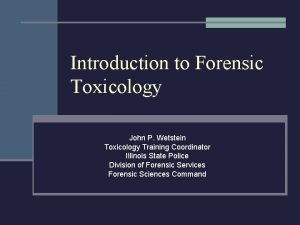Hashim A General principles of toxicology u Toxicology






























- Slides: 30

Hashim. A General principles of toxicology

u. Toxicology u. Branches u. Forensic toxicology u. Toxin

History u Ancient poisons Hemlock, Opium, Aconite

History u In 82 B. C. Sulla issued the Lex Cornelia in Rome – the first law against poisoning u

History v v Paracelsus is consider as father of toxicology v Orifila

Definition u Toxin/ Poisons u It is any substance which when introduced in to the living body or brought in contact with any part there it will produce ill effects or death, by its local or systemic action or both

Actions of Poisons v Local effect Corrosives: - Chemical destruction Atropine: - Mydriasis Aconite: - Tingling and numbness of nerve endings v Systemic effect Opiates on CNS Strychnine on spinal cord Heavy metals on multiple system

Actions of Poisons v Combined effect Carbolic and oxalic acid Phosphorus q Types of poisoning q fulminant: - Massive uptake of poisoning Death occurs very rapidly q Acute : Produced by single large dose or several doses taken in a short period of time

q Classification of poisons q 1) corrosives q 2) irritants q

u ii. Plant origin u iii. Animal origin u iv. Mechanical u 3) Neuro toxic poisons

u 4) cardio vascular poisons u

u 5) u 6) u 7) Asphyxiant poisons Miscellaneous poisoning Substance of dependence and abuse

Poison Information Centre u It provide immediate, round the clock toxicity assessment and treatment recommendation over the telephone for all kind of poisoning situation affecting people of all stages

Indian law on drug and poisons u a) Poison act b) Drugs and cosmetics act c) Drugs and cosmetics rules d) Pharmacy act c) Drugs control act

Toxicology and the Indian Penal Code Section 284 Lay down the penalty for any person causing harm to some body through rash or negligent handling of poison Punishment: up to 6 months in prison, or payment of fine, or both Section 299 Culpable homicide Punishment : up to life imprisonment Section 300 Murder Punishment : up to life imprisonment or death Section 304 A Rash or negligent homicide Punishment : up to 2 years or fine or both Section 324 Causing hurt by dangerous weapons or means (including poisoning) Punishment : up to 3 years or fine or both Section 326 Causing grievous hurt by dangerous weapons or means (including poisoning) Punishment : up to 10 years or life imprisonment

u General management of poison u correct life threatening parameters u ABCD of resuscitation

General management of poisoning u Assessment of patient’s condition u 1) levels of consciousness u Reed’s classification of comatose patients Group 0 Arousable Group 1 Respond to painful stimuli and have intact reflexes Group 2 Maximum responds to minimum painful stimuli Group 3 minimum responds to maximum painful stimuli Group 4 Deeply comatose

General treatment measure Ø 1) Management of CNS depression Ø coma cocktaile Ø Dextrose Ø Thiamine etc Ø nalaxone Ø 2) Management of respiratory failure Ø 3) Management of hypothermia and hyperthermia

u u u 7) General nursing care comatose patient turned over regularly maintain the airway Aspiration Physiotherapy Antibiotic

Stomach decontamination u Ingested poison Inducing emetics B. Gastric lavage Emergency- dilution of poison Poison in not soluble in lipid 1. Induction of emesis- conscious Syrp IPECAC Alternatives Home made- solution of mustard powder A.

u. Indication organic irritants, barbiturates, salicylates pesticides u. Contra indications u coma, corrosives, convulsion, respiratory distress

Special measures u u u Forced diuresis Haemodialysis Haemoperfusion Hyperbaric oxygen Artificial respiration Diuretics

u u u u Types of antidotes Mechanical Chemical Pharmacological Chelating agents Universal Biological

u Chelating agents u High affinity towards metals u BAL, DMSA, EDTA etc

Duties of the doctor Medical § § § § Assess the condition- ABCD of resuscitation Identify the poison Rout dosage time Hypersensitivity Mental state Consider associated injury

§ § Collect body fluid Assess hepatic and kidney functions ECG. EEG, abdominal X-ray, oesophagoscopy Supportive measures

u Forensic duties § § Food poisoning from a public eatery – public health authority must be informed private doctors- No legal obligation to inform police. Suicidal and accidental cases Homicidal cases- police under the section 176 IPC Doctors working under government hospital- inform all cases to the police

u If the police require information regarding a poisoning case- doctors must provide it u Collect and preserve each and every evidences u If the patient is on the verge of death- dying declaration should be taken u Patient dies or brought death- death certificate must not be issued- autopsy u Maintain detailed written record of every case of poisoning

Questions u 1. general management of poison u 2. indications and contra indications of gastric lavage u 3. gastric lavage solutions u 4. PIC u 5. role of a doctor in a suspected case of poisoning u 6. diagnosis of poisoning in living and dead body

u 7. role of antidote in poisoning u 8. chelating agents u 9. coma cocktail 10. universal antidote
 Why is charlie telling hashim jokes?
Why is charlie telling hashim jokes? What is your favourite subject?
What is your favourite subject? Ahmed hashim ibrahim
Ahmed hashim ibrahim Omar hashim quran
Omar hashim quran Hayder hashim md
Hayder hashim md Syukor hashim public gold
Syukor hashim public gold Dr mark hashim
Dr mark hashim Prophet muhammad family tree
Prophet muhammad family tree Dr ahmed hashim
Dr ahmed hashim Dr ahmed hashim
Dr ahmed hashim Banu dost
Banu dost Planos en cinematografia
Planos en cinematografia Where did general lee surrender to general grant?
Where did general lee surrender to general grant? What is toxicology?
What is toxicology? Toxicology excellence for risk assessment
Toxicology excellence for risk assessment Important dates in forensic science
Important dates in forensic science Define forensic toxicology
Define forensic toxicology A breath test reflects the alcohol concentration in the
A breath test reflects the alcohol concentration in the Forensic toxicology definition
Forensic toxicology definition Define environmental toxicology
Define environmental toxicology Chapter 8 toxicology poisons and alcohol
Chapter 8 toxicology poisons and alcohol Chapter 8 toxicology poisons and alcohol
Chapter 8 toxicology poisons and alcohol Toxicology management
Toxicology management Washington state patrol toxicology lab
Washington state patrol toxicology lab Forensic toxicology lab activity
Forensic toxicology lab activity Toxicology definition
Toxicology definition Toxicology and applied pharmacology
Toxicology and applied pharmacology North carolina medical examiner toxicology
North carolina medical examiner toxicology Toxicology
Toxicology Examples of toxicology
Examples of toxicology Toxicology
Toxicology






